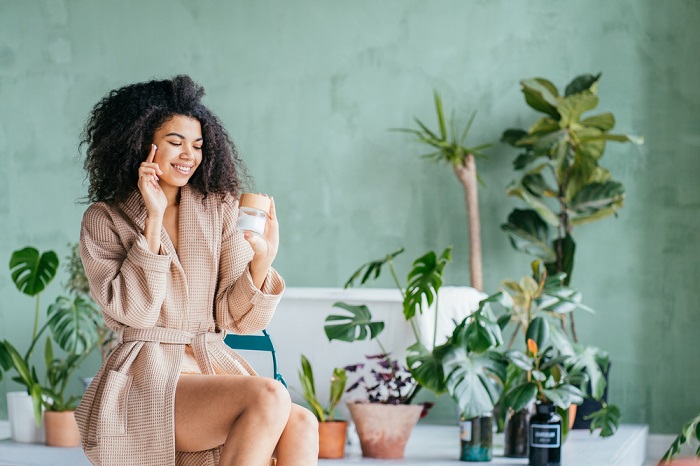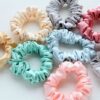
The clean beauty movement has received a groundswell of support from beauty mavens in recent years, and it doesn’t take much to understand why. In every industry from food to fashion, companies are responding to widespread consumer demand for products formulated and manufactured with a commitment to sustainability.
But what is clean beauty exactly? Whether skincare, haircare, or cosmetics, clean beauty is best thought of as a countermovement against a long history of cosmetics and personal care products shown to have harmful ingredients that lead to toxic effects on our bodies and the natural environment over time.
In this guide, we’ll take a look at why the ingredients in skincare matter and how to identify clean beauty products so you can glow up while doing right by your body and the planet.
Defining Clean Beauty
The Environmental Working Group reports that American women come in contact with more than 160 noxious chemicals per day through the use of beauty and personal hygiene products.
Historically, some of the most prevalent culprits have been:
- Phthalates – A substance primarily used to give plastic its elasticity, it’s also found in cosmetics and acts as an endocrine disruptor.
- Talc – A mineral that used to be used in products like baby powder, it can sometimes carry contamination from asbestos if untested.
- Parabens – Found in many hair and skin care products, parabens interfere with hormones by imitating natural estrogen in the body.
While the FDA hasn’t settled on any concrete criteria for labeling beauty products “clean,” clean beauty is ultimately about bringing cosmetic or personal care products back to basics. That means looking for products with plant-based formulas, clean ingredients that don’t knock the wind out of you to read, and a demonstrated commitment to fair trade partnerships with small farms and manufacturers.
3 Labels To Know in The World of Clean Beauty
While the clean beauty movement has seen a tremendous rise in demand from beauty lovers the world around, there’s a lot of mystique — and misconception — around some ‘clean product’ labels you’ll come across while browsing.
Let’s demystify some key clean beauty terms you should know if you’re gearing up to swap out your old products and embrace the clean beauty lifestyle.
1. Nontoxic
If a beauty product is labeled non-toxic, this means no studies have verified that the product has had health-hazardous effects on the user. There are several harmful chemicals to look out for, but here are a few to get you started:
- Formaldehyde
- Parabens
- Per- and polyfluoroalkyl substances (or PFAS)
- Phthalates
- Polyethylene glycol
- Silica
- Triclosan
- Toluene
Unfortunately, the U.S. has much more relaxed standards than other countries when it comes to identifying and discouraging the use of harmful chemicals in commercial products — of 1,300 additives that are restricted in the E.U., only 11 are prohibited in the U.S. To get your hands on truly clean beauty products, you’ll want to read the whole ingredients list beyond the chipper “non-toxic” label before incorporating a product into your beauty and makeup routine.
2. Organic
You’re probably familiar with the term “organic” if you’ve ever dipped a toe into the world of clean eating. But you’re starting to see it pop up in the realm of beauty and skincare, too.
Ideally, a truly organic beauty product meets the following requirements:
- At least 95% organically derived
- No GMOs
- No pesticides
- No synthetic fragrance or dye
- Compliant with USDA-certified production and handling protocol
When it comes to clean beauty standards, achieving an official USDA Organic label can be prohibitively pricey for many beauty brands. So, it’s more likely you’ll encounter the term integrated into the clean beauty product description rather than the official USDA stamp.
3. Vegan
Like the vegan diet, vegan beauty products are made with zero main or trace ingredients derived from animals and other creatures, such as beeswax. Many vegan beauty products are also cruelty-free, as the companies that produce them tend to have a vested interest in animal welfare built into their clean beauty brand.
The Give and Take of Clean Beauty
Nontoxic, organic, vegan, cruelty-free — there are many avenues for purifying your beauty supply. However, unless you’re dedicated to washing your face with water alone, you’ll find there’s often a give and take involved in making the transition.
At the end of the day, clean beauty is all about minimizing impact and harm while maximizing a commitment to gorgeousness with longevity and conscience. Like any path towards self (or collective) improvement, it takes baby steps — and if you’re here, you’re already well on your way.
Sources:
- Medical News Today. Are some makeup ingredients toxic? https://www.medicalnewstoday.com/articles/327318#list-of-ingredients-to-avoid-and-why
- The Washington Post. ‘Clean’ beauty has taken over the cosmetics industry, but that’s about all anyone agrees on. https://www.washingtonpost.com/lifestyle/wellness/clean-beauty-has-taken-over-the-cosmetics-industry-but-thats-about-all-anyone-agrees-on/2020/03/09/2ecfe10e-59b3-11ea-ab68-101ecfec2532_story.html
- Harper’s Bazaar. The Ultimate Guide to Clean Beauty. https://www.harpersbazaar.com/beauty/skin-care/a28352553/clean-beauty/#buzzwords
- Earth Island. The Environmental Impact of Essential Oils. https://www.earthisland.org/journal/index.php/articles/entry/the_environmental_impact_of_essential_oils/





